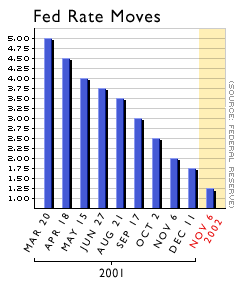NEW YORK (CNN/Money) -
Federal Reserve policy makers seem almost certain to leave their key short-term interest rate alone this week, but their meeting will still generate suspense, with economists and Wall Street hanging on their words, if not their actions.
The central bank's policy makers meet Tuesday and Wednesday to talk about the uncertain state of the U.S. economy and what, if anything, they can do to help it.
Cutting the federal funds rate, the most effective tool in the Fed's utility belt, seems out of the question -- a recent Reuters poll of 22 "primary dealers," banks that do business with the Fed, found that exactly none of them expected a rate cut this week.

But the unanimity eroded when it came to guessing how the Fed will describe the risks it thinks the economy faces.
When Fed policy makers end their meetings, they issue a terse statement about their decision on interest rates and the state of the economy. In recent years, the Fed has either said the risks to the economy were tilted toward weakness, tilted toward inflation, or balanced between both headaches.
Of the 22 dealers Reuters polled, 16 said they thought the Fed would keep the "balanced" view it has held since its meeting in November 2002. Two dealers offered no guess about the statement. But three said they thought the Fed would shift gears and say the risks to the economy were tilted toward weakness.
Few people seriously believe the risks to the economy are really "balanced" at this point -- 2002 ended with nearly 200,000 job cuts in November and December, a less-than-stellar holiday season for retailers, and fourth-quarter gross domestic product (GDP) growth likely close to zero.
"Given that some of the news of late ... has been on the weak side, and given that the Fed's own Beige Book report reflected weakness, they might show an inclination to cutting rates in the future," said Anthony Crescenzi, bond market strategist at Miller Tabak & Co.
But the Fed has proven its willingness to use its statement, often called its "bias" statement, in unexpected ways. When it adopted its "balanced" view in November, for example, it also cut its target for short-term interest rates by half a percentage point to 1.25 percent, a level not seen since July 1961.
Since most economists thought the Fed was actually pretty nervous about the state of the economy, its "balanced" outlook looked more like a way of telling people not to expect another cut any time soon -- and maybe telling people to cheer up while they were at it.
"With each rate cut, the Fed used to say, 'Get excited about the cut, but let's dampen down sentiment by saying the economy looks like a mess as far as the eye can see,'" said Rory Robertson, interest rate strategist at Macquarie Equities (USA). "They were working against themselves."
With this in mind, the Fed might cling to its "balanced" view until ugly economic data are smacking it in the face.
The Fed might also want to wait for the Iraqi picture to clear up. For months, the Fed has said "geopolitical uncertainty" is Economic Enemy No. 1, and many economists agree, saying worries about a U.S.-led war in Iraq are keeping businesses from spending money or hiring people.
According to this logic, these same businesses will get in a hiring mood once Saddam Hussein is quickly and cleanly dethroned, and the economy will pick up, meaning the Fed can take the rest of the year off.
What's more, not all of the economic news has been awful. The latest survey of manufacturers by the Institute for Supply Management showed some hope in that tortured sector, the number of weekly claims for unemployment benefits has slowed from a hemorrhage to a trickle, and the seemingly always-reliable housing market is still strong.
Meanwhile, Congress is busy hashing out the details of what seems likely to be a huge gift basket of tax cuts and spending programs designed to jolt the economy into motion. The Fed might want to get a better idea of the dimensions of that package before it makes any major policy moves of its own.
Of course, there's always the risk that solving the Iraq situation won't be quite the miracle cure people hope it will, and an economic stimulus package could be slow in coming, given how argumentative legislators can be.
If the economy continues to struggle, with Iraq and Congress unable to give it a boost, the Fed likely won't hesitate to cut again, even with rates already close to zero.
"I'm assuming we are going to see some positive effects from [the stimulus package] in the second half of the year, but the first half is quite vulnerable," said Northern Trust economist Paul Kasriel. "If the first quarter is looking peaked, and the unemployment rate is moving up, the odds would mount for some kind of a second-quarter rate cut."

|

